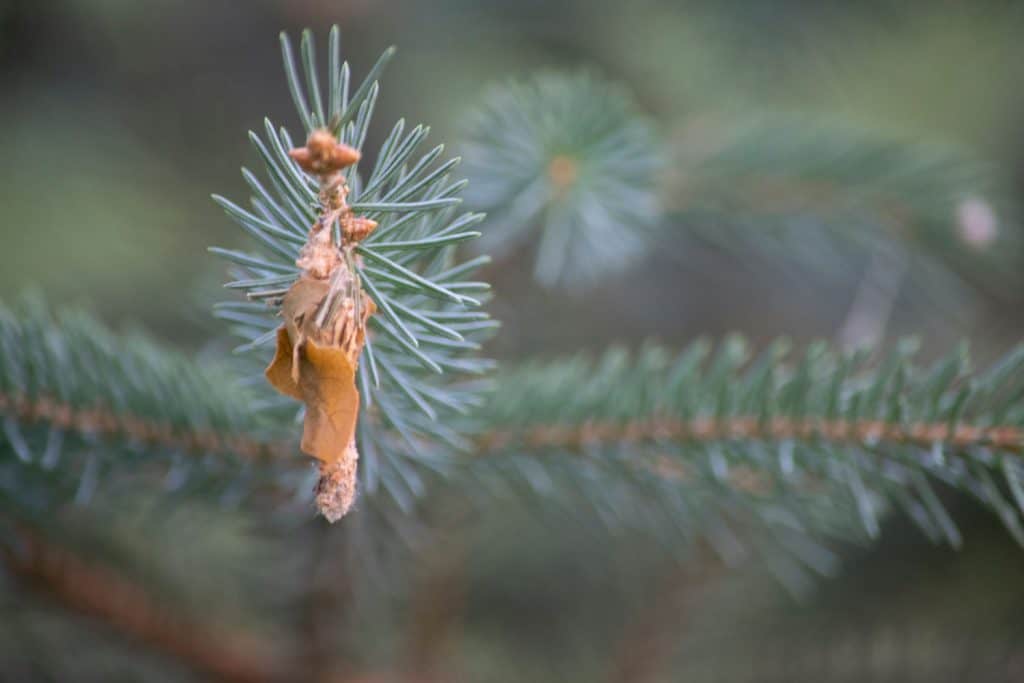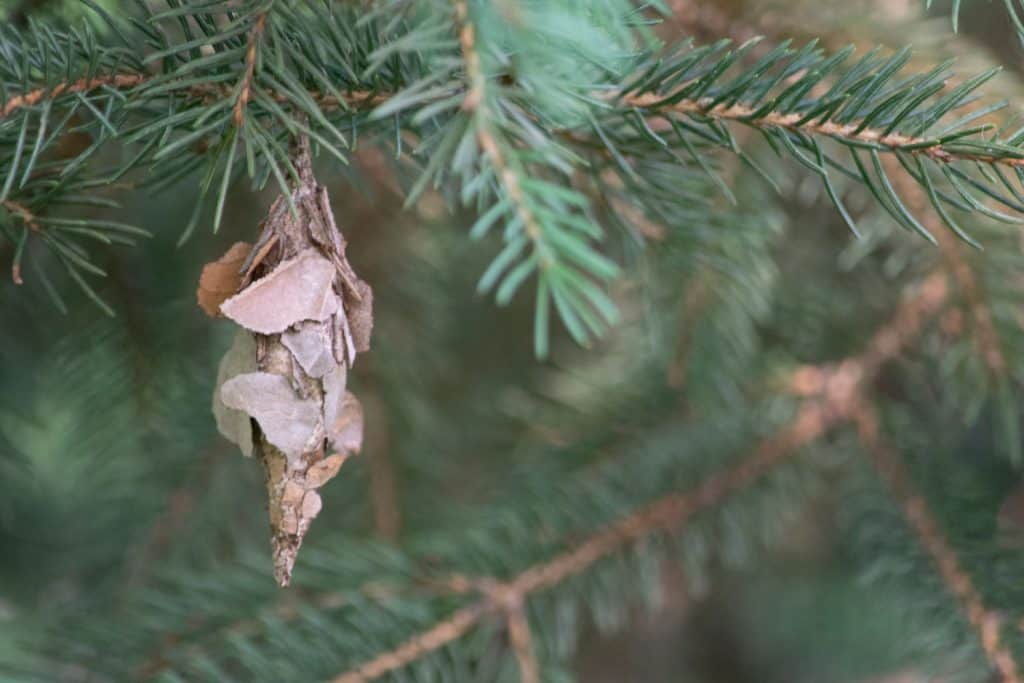If you are a gardener, you may be familiar with bagworms and the damage that they can inflict on plants. Similar to other plant pests, bagworms can cause noticeable damage to plants in a matter of weeks if left untreated. For this post, we have researched the most common plant types to suffer from bagworms and how to prevent them from ravaging your beloved plants and shrubs.
Bagworms are known to feed on spruce, pine, juniper, cedar, various shrubs, and evergreen trees. However, their appetite for plants and shrubs isn't limited to this list. Anywhere that they can spread and find a reliable resource, they will multiply and multiply. Preventing bagworms includes using various pest control methods and keeping a close eye on your plants, trees, and shrubs to monitor for activity.
These fast-multiplying pests can also feed on forests, orchards, and shade trees of nearly every kind, in addition to various perennials. So to say, they aren't the pickiest eaters. However, their feeding activity can leave your lawn riddled with half-eaten leaves and infected trees. Keep reading to learn how to prevent bagworms and how to eradicate them once you have them.
![A bagworm on a branch of a pine tree, What Kind Of Plants Do Bagworms Eat? [And How To Prevent That]](https://gardentabs.com/wp-content/uploads/2021/10/What-Kind-Of-Plants-Do-Bagworms-Eat-And-How-To-Prevent-That-683x1024.png)
Signs of A Bagworm Infestation
There are specific symptoms that your trees will display if they're infected with a bagworm infestation. Let's take a look at the most common ones:
- A sudden or dramatic change in the appearance of your evergreen trees or shrubs. This may include thinning of the tree's leaves or the appearance of brown spots on branch tips.
- A small, pine-cone-shaped bulb (about an inch in length) hanging from the tree branches (you may notice the bag wiggling).
- The leaves on the tree suddenly become brown or pale as if she planned is dying.
- The needles or leaves of the tree appear ravaged and are falling off the tree.
- Brown-lined holes on the leaves of the trees.
Side note: Though bagworms are unlikely to kill a tree, they can cause its leaves to die off and fail to grow back.

4 Ways to Prevent Bagworms
A couple of notable that you can do to prevent a bagworm infestation is to keep your plants healthy and inspect their branches for bagworms. Also, when purchasing new baby trees, be sure to carefully inspect the branches and leaves to ensure that you're not buying a tree that is already infected with bagworms. This can cause the pests to spread directly to your entire landscape or garden.
Remove them by hand
If your yard is small or full of shrubs and small trees, it may be easier to remove the bagworms by hand. To do this, don a pair of latex or workers gloves and go from tree to tree, plucking them and then placing them in a plastic garbage bag.
If you have trees taller than seven feet, you may want to take your ladder to reach the higher branches. After collecting all of the bagworms, you can burn the trash bags or take them to a local arborist who can destroy them for you. Be sure to completely seal the bag so that they do not find their way and to your vehicle.
Encourage natural predators
Note that insect predators such as owls, birds, possums, and mice will feast on bagworms, and they may care for the problem for you. You may even find woodpeckers and sparrows nibbling on the eggs and bagworm nests on your trees.
If you prefer a natural removal process, try to encourage wildlife predation by making your garden or yard a bit more bird and wildlife-friendly. This involves reducing the amount of pesticide spray on your plants or trees.
Monitor your garden or yard
It's always best to monitor your trees and shrubs for pests at the start of the spring season. If you notice any camouflage pine cone-shaped bulbs appearing on the leaves of your plants, be sure to remove them by hand and destroy them as soon as possible.
You can also apply a pesticide if you have a larger infestation area to cover. The one thing you want to prevent is spreading in the bagworms to your other plants--so use caution when transporting them.
Spray With Bacillus thuringiensis (also known as "Bt")
Bacillus thuringiensis is a soil bacterium that sickens bagworms and causes them to die very quickly. The solution comes in a spray, and it's best to apply it to larvae or on young worms that have just hatched out of the bag. This usually happens sometime between May and June. You can purchase bacillus thuringiensis from your local nursery, gardening store, or online for about $20 per gallon.
Find Bacillus thuringiensis on Amazon.
Apply pesticides
And, of course, there are always chemical pesticides that you can apply to your garden or yard. Keep in mind that it's best to preserve pesticide use for only severe bagworm infestations. Or, if you have a valuable garden or an orchard business, this method may be best to eliminate the bagworms or prevent them from appearing altogether.
The most common chemical pesticides used for bagworms are spinosad, acephate, and cyfluthrin. If you prefer something that has low toxicity to humans and pets, then spinosad is the best way to go. Also, be sure to do not apply the chemical pesticide on a windy day, as it can cause the product to dry too quickly or drift away in the breeze.
Do bagworms eat roses?
Yes. Bagworms love shrubs, and this includes roses. These fast-munching creatures will spend their time feeding on the leaves and flowers of rose bushes, leading leaving them riddled with brown spots and holes. To remove them from your rose bushes, you can employ the typical run-of-the-mill pesticide methods, including commercial pesticides or plucking them by hand.

You can also introduce natural predators or treat them with Bacillus thuringiensis using a hand sprayer. Before applying the Bt, be sure to know the correct concentration amount, which should be located on the label. This solution is extremely concentrated, and in many cases, you only need anywhere from three to four teaspoons per gallon of water.
Also, know that these microbes degrade fairly quickly and sunlight. So it's best to apply the treatment during the evening once the sun goes down.
What are bagworms attracted to?
Bagworms are attracted to any thin or needle-like leaves that they can chew and feed on. These pests prefer trees, shrubs, and plants located in hot and humid areas. This explains why they are extremely popular in coastal states such as Florida, Georgia, California, Texas, and Louisiana.
They are known for their specific love of evergreen trees. They can become a bigger threat in agricultural landscapes where commercial pesticide use is relatively high—because they kill and deter natural predators of bagworms.
What trees do bagworms not like?
You may be surprised to learn that bagworms aren't that picky. However, their appetite may be limited to plants with thicker skin, such as succulents and cacti.

They prefer trees with smaller and narrow leaves. However, they will feast on other types if their resources are low. They also feed on flowers, shrubs, and fruit trees, if available.
How did I get bagworms?
If you have a bagworm infestation in your lawn and garden, the chances are that the pests migrated to your area from nearby plants. Bagworms can also be spread by the wind, believe it or not. Note that you may increase the likelihood of your garden getting bagworms if you regularly apply pesticides to the outdoor area—they're just that common.
How do bagworms spread?
A bag of worms are prolific breeders, and they typically spread from tree to tree by either an adult female moth or larvae that crawl over to nearby plants. One host plant (aka "bag") can lead to the dispersal of hundreds of larvae (any from 300 to 1,000 in a bag), resulting in very high populations on some plants in a particular area, while others nearby may only experience a small infestation.
These moths love cedar trees specifically. So if you have a lawn full of cedars, it's best to keep an eye on potential bagworm infestations during the spring and fall months--their prime growing times.
Wrapping Things Up
Though a bagworm investigation typically will not kill your trees, it can make them unhealthy and unsightly. If you prefer to use a non-invasive method, consider removing them by hand or using natural predators to bring their population down. However, a commercial pesticide such as spinosad may be best if you have a more invasive infestation.
Before you go, be sure to check out some of our other posts:


